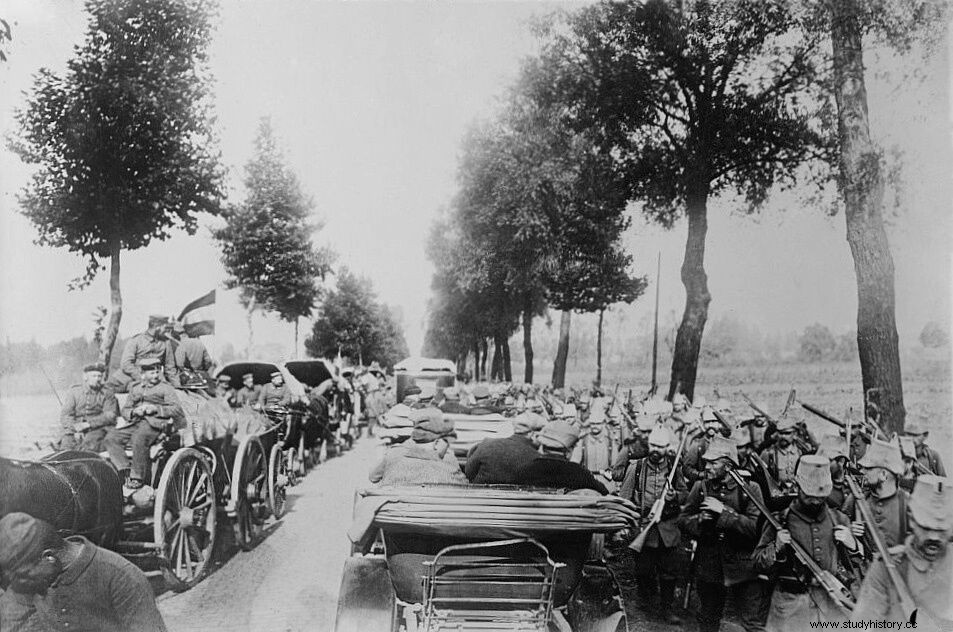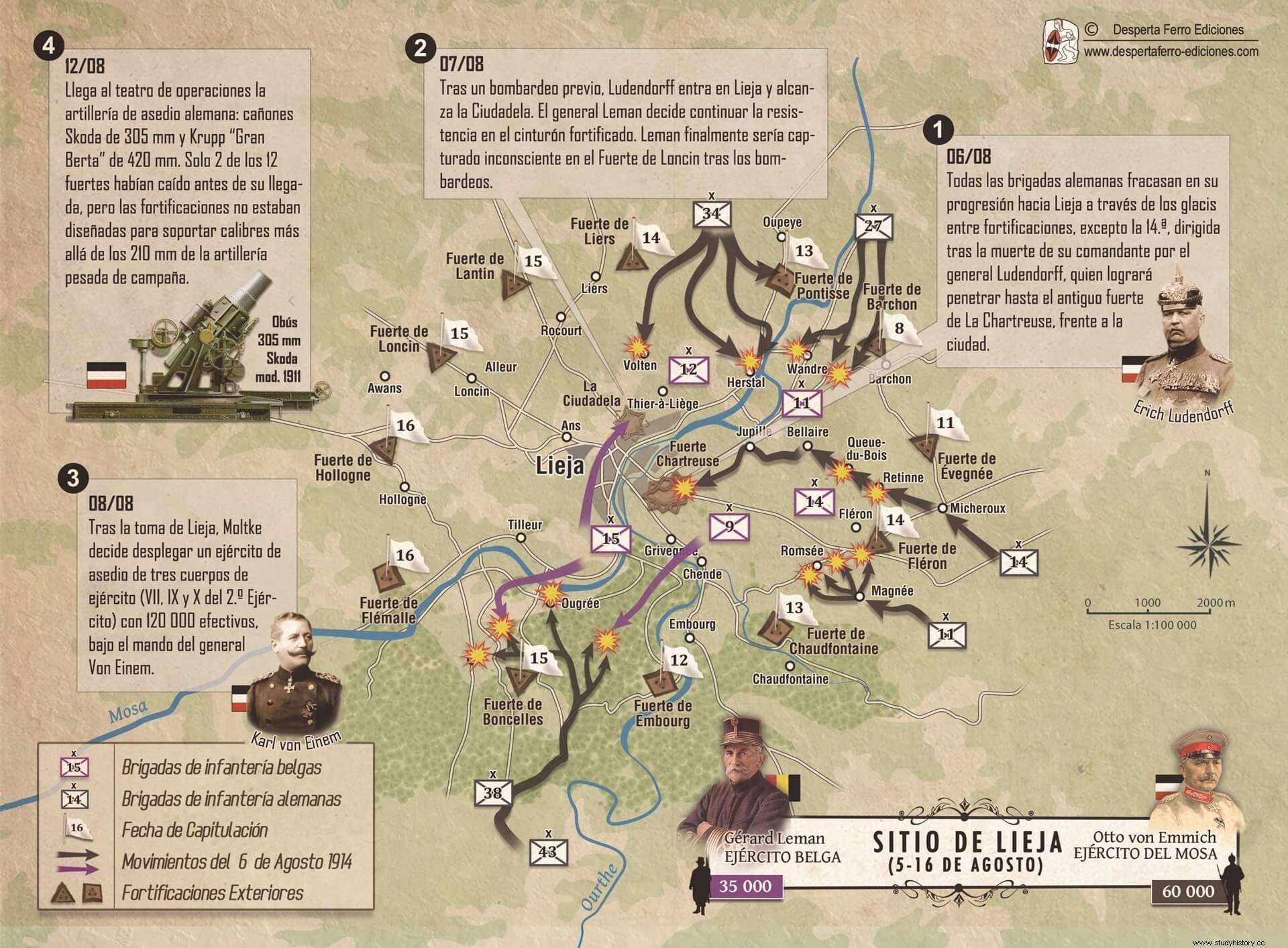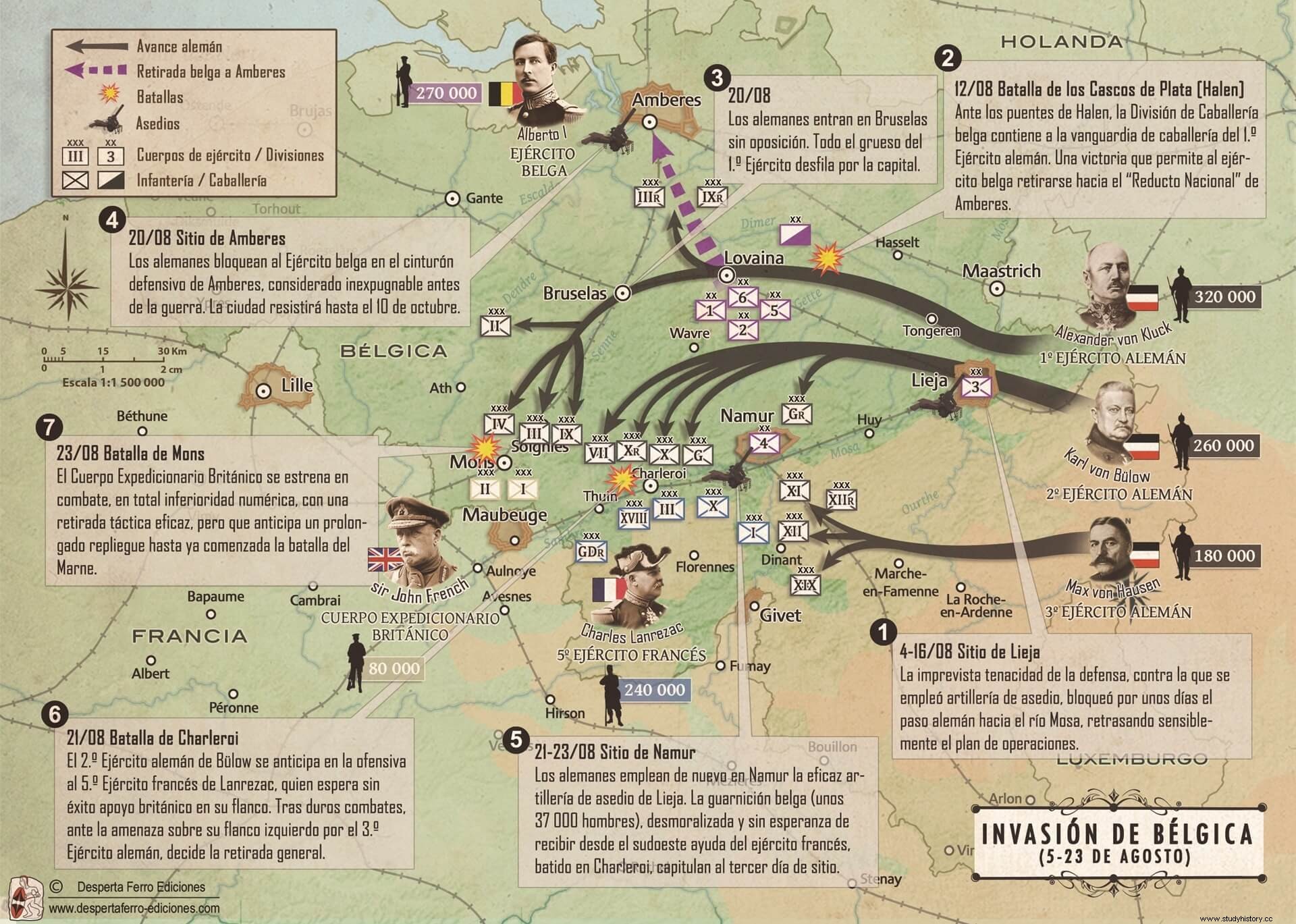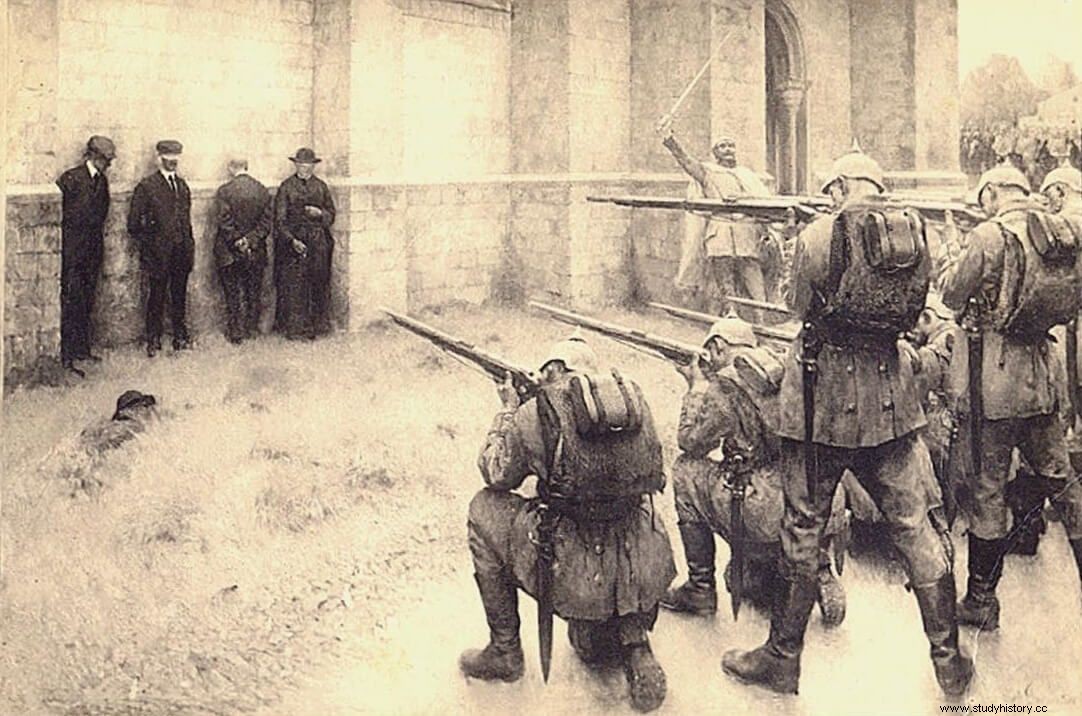
In 1914, no European leader wants war, but everyone is convinced that the others love her. The announcement of the attack in Sarajevo it does not arouse any special impression in Europe; and Belgium is no different. The death of Franz Ferdinand, the inheriting archduke of the Habsburgs, "does not concern Belgium at all," according to what could be read in the country's press. However, Russia's mobilization definitively commits Europe to the path of war. Belgium then finds itself, despite herself and for the first time since 1830, involved in a European conflict. The First World War marks a turning point in national history; his war experience is unique in Western Europe. This parliamentary monarchy, a great industrial and colonial power, finds itself between France and Germany, two opposing states but guarantors of its neutrality. However, at the beginning of the 20th century, his fate seems to be cast:the German and French general staffs plan to wage war on his territory.
On August 4, Germany will violate Belgian neutrality despite being contemplated by the treaties of 1839. Mortally wounded by this aggression, Belgium will come out of the war in a few weeks. The Belgian army, poorly prepared, fights and resists valiantly, so for allies and neutrals it becomes a symbol that justifies waging war in the name of civilization and against barbarism. Only Serbia and Romania were also almost completely occupied until the end of the war. The violation of neutrality, the brutal invasion and the almost total occupation of its territory will shock the population and the international community.
Neutrality
In June 1815, the Congress of Vienna it established a European concert that rested on a balance of powers that played in favor of the British. Great Britain, Russia, Austria and Prussia agreed to respect the treaties. Together with France, which would join them in 1818, they collegially managed European problems through diplomacy. The goal was to respect borders and reach consensus in the face of all threats to peace.
This balance was endangered by the outbreak of the Belgian revolution in August 1830, but the country's independence in 1831 showed that the European agreement was flexible. The creation of an independent and neutral kingdom of the Netherlands was the option chosen by the European powers. Belgium could not direct its foreign policy according to her preferences and interests. The states undertook to respect her status and to defend her against any aggression. Great Britain, France and Prussia would be the guarantor that no power would try to invade Belgium. Until 1914 Belgian neutrality it was an essential factor for peace on the continent, "the cornerstone of European balance" according to Louis Philippe, King of the French. For Prussia and Great Britain, the new state was a barrier against France. For this, it affirmed its growing power and contributed to the Franco-British rapprochement. In addition, the security of its northern border was guaranteed.
Until 1914, Belgium's foreign policy was summed up as preserving its integrity and "avoiding armed conflict at all costs". After the Prussian victory in 1871, the relationship of forces was altered in Europe and suddenly, for the Belgians, the threat changed borders. At the dawn of the 20th century there were many who, within the Belgian political class, were convinced that, in the event of a new Franco-German war, neutrality would not be respected and they understood that they could not continue to rely on the competition disinterested in Britain. The collaboration between the French and British military and diplomatic circles materialized in the signing of an agreement in 1911 that provided, in case of violation of the 1839 treaty, the sending by Great Britain of an expeditionary force to France, but the Belgians They were denied the possibility of entering their territory preventively in the face of a German threat. The Belgian diplomacy and Army were forced to define their plans in the face of the hypothesis of both a German and a French invasion. In January 1904 the risk of German aggression materialized when Leopold II and William II They met in Berlin. The two monarchies were discussing colonial and military matters when the German emperor suggested annexing French Flanders, Artois and the French Ardennes. The Belgian king reacted with disdain to this proposal, so the German emperor declared threateningly:"If Belgium does not support me, I will only be guided by strategic considerations."
An Army in Remodeling
The Belgians had been sheltered behind the shield of neutrality for a long time and even the very question of maintaining an army was called into question by certain quarters. However, the threat posed by neighboring powers encouraged the Belgian government to provide the country with military resources. Defense matters, like foreign affairs, were among the king's prerogatives. In the event of aggression, Belgium had two alternatives:to wait for the armed intervention of a guarantor power or to equip itself with an army and fortifications capable of dissuading an invasion.
Despite the reluctance of the Belgians, Leopold II and later Albert I were tempted to reform the Royal Army in depth, emphasizing the defense of the territory, relying on the triangle formed by Antwerp, Namur and Liège. Recruitment reform was a priority:in 1913, compulsory and universal military service was adopted. and Belgium would stop counting only on the humblest for its defense. An effort was also made to reorganize the high command, rearm the troops, and create new units.
However, the generalization of military service and the increase in the war budget, which testify to the desire to reinforce the means of defense, did not solve everything:the Belgian Army was still in bad shape valued in Europe; poorly trained, poorly equipped and with an outdated conception. Command was considered to be of mediocre quality. The army suffered from serious recruitment deficiencies while the Flemish and Walloons did not participate on equal terms, since the former were led by the latter and the language used was French. In addition, the Belgian High Command was doctrinally divided regarding the strategic decisions to be applied and, consequently, did not have a defined operational plan; in August 1914, he was still mired in the midst of the reforms undertaken, which were far from being completed.
Belgium in military plans
In 1898 General Alfred von Schlieffen, chief of the German General Staff, began to develop a plan that consisted of containing the Russian troops in the East and quickly destroying the French army in the West, first, to then turn against Russia. The key to success lay in speed of action, and to achieve this, the German army had to surround the Séré de Rivières defensive system. Therefore, the peculiarity of this plan lay in the need for the right wing to penetrate to the north into Luxembourg and Belgium, so that, since the elaboration of the Schlieffen Plan , the fate of Belgian neutrality, of which Germany was instead one of the guarantor powers, was written. Schlieffen considered that Germany should take this risk in order to achieve victory as quickly as possible.
The French knew the outlines of the German plan. In 1904, the Deuxième Bureau [N. del T.:military intelligence office of the General Staff] managed to obtain a version of the Schlieffen Plan through a high-ranking German officer (the Vengeur affair) and the question of the entry of French troops into Belgium began to be strongly raised . General Michel, appointed chief of the General Staff in 1910, already included in his plans the hypothesis of a German attack on Belgium, but his project was not accepted and he resigned. His successor, General Joffre , also counted on the eventuality of a German overflow along the northern border and for this reason it was proposed to take the initiative in Belgium, but the French government rejected such a hypothesis, fearing that Great Britain would withdraw its support from France; on the contrary, France was rather interested in the Germans being the ones to violate Belgian territory in the first place. Thus, General Joffre immediately introduced an offensive plan in the east against the German army, Plan XVII, which did not contemplate penetrating Belgium and in which the Franco-Belgian border was to be garrisoned by the British.
Towards the violation of neutrality
On July 29, while the delegates of the Second International gathered in Brussels launched an appeal for peace, the Belgian executive sought guarantees from the European powers for its neutrality. Germany refrained from any response. For its part, France ordered its forces concentrated on the borders to withdraw ten kilometers from the Belgian border and not to make any movement in that direction except in case of attack.
Germany's declaration of war on Russia and the violation of the neutrality of the Grand Duchy of Luxembourg, on August 2, forced the British Cabinet to meet. They hoped that the threat of violating Belgian neutrality would end up convincing British public opinion, divided by a war on the continent against Germany. German diplomacy, believing that Belgium would grant the right of passage, addressed an ultimatum to him. . This caused a tremendous impact in the country; the population was against it and the king and the government did not hesitate about the answer to give:they chose to defend their neutrality by means of arms . At 8:00 the invasion of the territory began and when the Belgian Government found out, its Minister of Foreign Affairs sent telegrams to Saint Petersburg, London and Paris requesting military aid.
On the 4th, the British ambassador to Germany sent a British ultimatum to the German foreign minister, which was not well received by the chancellor, Bethmann-Hollweg:
Again, Belgium was about to become Europe's battlefield. Their status of neutrality and rejection of military issues had made the Belgians doubt the usefulness of maintaining an army that, despite its limitations, was going to show their country and the world an unexpected image. Albert I, to galvanize national sentiment, recalled in his proclamation to the army and the nation, on August 5, the victorious battle of the "Golden Spurs" [battle of Courtrai] in 1302 against the French and the resistance of the 600 Franchimontes against the Burgundians and French in 1468. Belgium chose to defend itself against the invader.
The Belgian Army in combat:Liege
The German attack aroused deep patriotic sentiment within the population. The Belgian army was determined to resist, which surprised the Germans. Thus, on August 4 at noon, when the German cavalry reached the Meuse at Visé, they found that they could not cross the river because the bridge had been destroyed by Belgian engineers. Above all, they were met by gunfire from the troops of the 12th Line Regiment. In Visé the first Belgian combatants died for their country s:Privates Louis Maulus and Prosper Van Gastel, from the 12th Line, and Gendarmes Auguste Bouko and Jean Pierre Thill.
Despite a lack of organization, the Belgian mobilization was successful and morale was excellent. King Albert I led the army and for the Belgian authorities the objective was threefold:he had to resist the German troops, specifically around the fortified position of Liège , slow down the enemy advance, carefully avoiding the destruction of the bulk of the Belgian forces (around 270,000 men), and protect the Antwerp “National Redoubt”. Finally, the help of the French and British armies would be vital for them.

For the German Army, the rapid conquest of Liège was of great strategic importance. General Gerard Leman commanded the Belgian 3rd Division and the fortified position in Liège. The "Burning City" was surrounded by moats and twelve forts. The Germans, who knew these fortifications well, knew that the defenses were outdated. From August 5 the Germans besieged the city. The Belgians resisted the violent confrontations that made it possible to stop the assailants or contain the retreat. On August 6, General Erich Ludendorff took command of the 14th Brigade and in the morning the German army seized the heights of Jupille and controlled the fort of La Chartreuse , with which he dominated Liège. The artillery was then able to begin the bombardment of the city and on the morning of August 7, German elements sent by Ludendorff penetrated Liège and seized the bridges over the Meuse and the citadel. At that time, since the fighting in the city had aroused enthusiasm, particularly in France, the city of Liège was decorated with the Legion of Honor.
On August 7, German forces took Liège, but were caught under fire from the holding outer forts. The Germans were reinforced with 420 mm howitzers and by August 11 the heavy artillery came into action. On August 16, the fort of Hollogne he was the last to capitulate.
The capture of Liege It was the first major event of the war. The fortified position of Liège had succeeded in delaying the German army, although it had just gained a clear tactical and strategic advantage. The Liège attack dispelled the last doubts, particularly British, about German intentions to pass through Belgium. For its part, the German General Staff did not expect such Belgian resistance.
The withdrawal of the allied armies
After the fall of Liège, the Belgian General Staff awaited French and British reinforcements. King Albert I avoided the head-on clash to save his army from destruction. On August 12, Lieutenant General Léon de Witte, commander of the Belgian Cavalry Division, succeeded in blocking two divisions of Georg von Marwitz's Cavalry Corps at the Halen bridge. . Horsemen from the 1st and 2nd Guides and 4th and 5th Lancers regiments, reinforced by a battalion of cyclist carabinieri and supported by a group of mounted artillery and pontoon engineers, held the last bridge over the Gette . This success aroused enthusiasm in Belgian and even European public opinion:the bulk of the Belgian army was not isolated from the Antwerp redoubt. This combat received the name "the battle of the silver helmets" [battle of Halen] because of the German helmets found on the battlefield, with their silver girdles, and in memory of the battle of the Éperons d'or [battle of of Courtrai] from 1302.

Despite success, the situation of the Belgian army she was compromised. On August 18, while the German army attacked north of the Meuse, Albert I ordered, despite French protests, the withdrawal towards Antwerp and on August 19 he was already behind the Dyle River, although he was still fighting rearguard combat, such as in Aarschot, for example. On August 20, the Germans entered Brussels while Albert I kept his troops withdrawing towards Antwerp, effectively breaking Franco-Belgian military collaboration.
And what about the allied device in Belgium August 20? A gigantic gap opened between the high Gette and the fortified position of Namur. Sordet's French Cavalry Corps took up position, but was already badly worn. On 12 August, General Lanrezac's 5th Army marched in the direction of Charleroi, which he planned to link up with the British Expeditionary Corps on 24 August. On the other hand, the French High Command ordered the 3rd and 4th armies to march towards Arlon and Neufchateau to penetrate through the Ardennes massif. Thinking that they would meet no resistance, the French advanced through unsuitable terrain for military operations, but on 22 August the fighting was fierce and both armies were forced to withdraw after sustaining heavy losses. That day became the deadliest in French military history to date. Between 20,000 and 30,000 soldiers perished on the battlefield, mostly on Belgian soil. In the Charleroi region, Lanrezac's 5th Army was isolated. There, too, the French efforts would end in failure:they failed to establish contact with the British and could not count on the protection of Sordet's Cavalry Corps. After having tried to contain the German thrust, Lanrezac was forced to withdraw and with his removal led to the isolation of the British Expeditionary Corps. This had landed at the ports of Le Havre, Boulogne and Rouen on August 12. They were good soldiers who would have to prepare to face the German divisions around Mons alone. The German offensive was launched on August 23 and, despite their superior numbers, failed to break through the British defenses. However, isolated and exhausted, Marshal French's troops withdrew on the morning of August 24, and the men of the German 1st Army crossed the Mons-Condé canal en masse, at the same time that the fortified position of Namur was stormed. . The shells that had crushed Liège had been bombarding Namur since August 22. On the 23rd, the forts were silenced, although the resistance would last until the 25th of August. Cut off and without hope of relief, General Michel ordered a retreat while the fortified position was forced to surrender.
On August 24, 1914, the French High Command concluded that their offensives in Belgium had failed. French and British had lost the battle across the borders as the Germans achieved an incontestable victory.
A brutal invasion
The first weeks of the war were a period of chaos in Belgium. The invasion shocked the population, seized with panic at the extreme brutality of the German army. Facing unexpected resistance from the Belgian army, the Germans warned the authorities and the population that they were prepared to repress any opposition to their march through the country, but the Belgian army offered resistance. As is common in wars, the movements of an army are accompanied by numerous abuses against the civilian population. The Belgians were victims of looting, robbery, looting; the houses were destroyed and the inhabitants executed. On August 19 and 20, in Aaschot, 150 people were shot and several hundred houses destroyed. On August 20, more than 200 civilians were put to death in the Ardennes. On the 23rd in Dinant, 674 civilians were executed by the German army. On the 25th, the city of Leuven was totally destroyed and more than 200 people died.
The German soldiers were stunned by the resistance of the Belgian army. They, too, were terrified at the prospect of having to fight snipers behind his back. The advance of the German troops was carried out with great prudence and fear; For its part, among the population the invasion caused an increase in hatred . The indignities towards the civilians diminished as the German armies changed the direction of their march in a south-westerly direction, after the capture of Brussels; now that they were progressing towards France, they stopped meeting resistance. The mass atrocities committed against the civilian population, such as those that had been recorded at the beginning of the campaign, especially in eastern Belgium, ceased in September. In total, and despite the current difficulties in drawing up an accurate balance, it is estimated that between 5,000 and 5,500 Belgian civilians (men, women, children and the elderly) perished during the invasion.

Why did the German Army indulge in these massacres? The latest investigations tend to show that there was no widespread sniper action in Belgium, as happened in France in 1870, nor that the military authorities wanted to terrorize the population. The atrocities committed are explained before by the collective psychosis that seized the German soldiers, but also because of their war inexperience and the fear that arose among them.
Conclusion
Signed by the world after the violation of Belgian neutrality, the German Army was once again discredited by the massacres among the population. The image offered by Belgium at the international level contrasted with that of the pre-war period. Its army and its population were considered heroic, its king aroused admiration. The sufferings of the Belgians served the allied propaganda; By denouncing these brutalities, the French and British justified their confrontation with Germany. In the name of justice, the war waged by the allies became that of civilization against barbarism :Belgium was a martyred country before being occupied. The invasion by the German army was a trauma for the Belgian population, convinced until then of the inviolability of its territory. However, in a few weeks the country was almost completely occupied by Germany.
Bibliography
- Bourlet, Michaël (2012):La Belgique et la Grande Guerre. Paris, SOTECA.
- Claisse, Stéphanie and Thierry Lemoine (2005):Comment de sortir de la Grande Guerre. Regards sur quelques pays “vainqueurs”:la Belgique, la France, la Grande-Bretagne. Paris, L'Harmattan.
- Dumoulin, Michel et al. (2006):Nouvelle histoire de la Belgique, volume 2:1905-1950. Brussels, Complexe.
- Horne, John (2005):1914:les atrocités allemandes. Paris, Tallandier.
- Schaepdrijever, Sophie de (2004):La Belgique et la Première guerre mondiale. Brussels, Peter Lang.
- Stengers, Jean and Eliane Gubin (2002):Histoire du sentiment national en Belgique des origines à 1918. Brussels, Racine.
